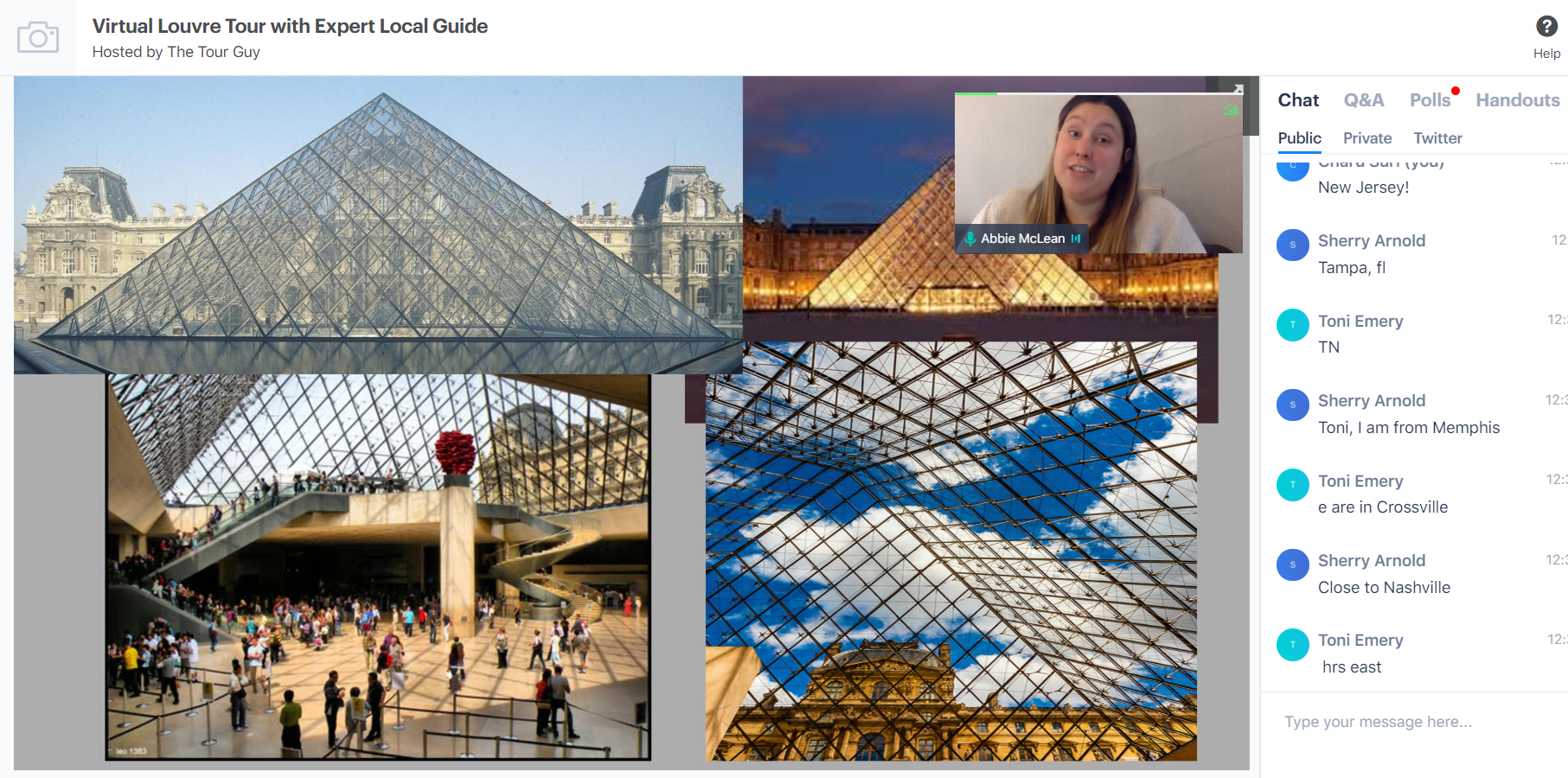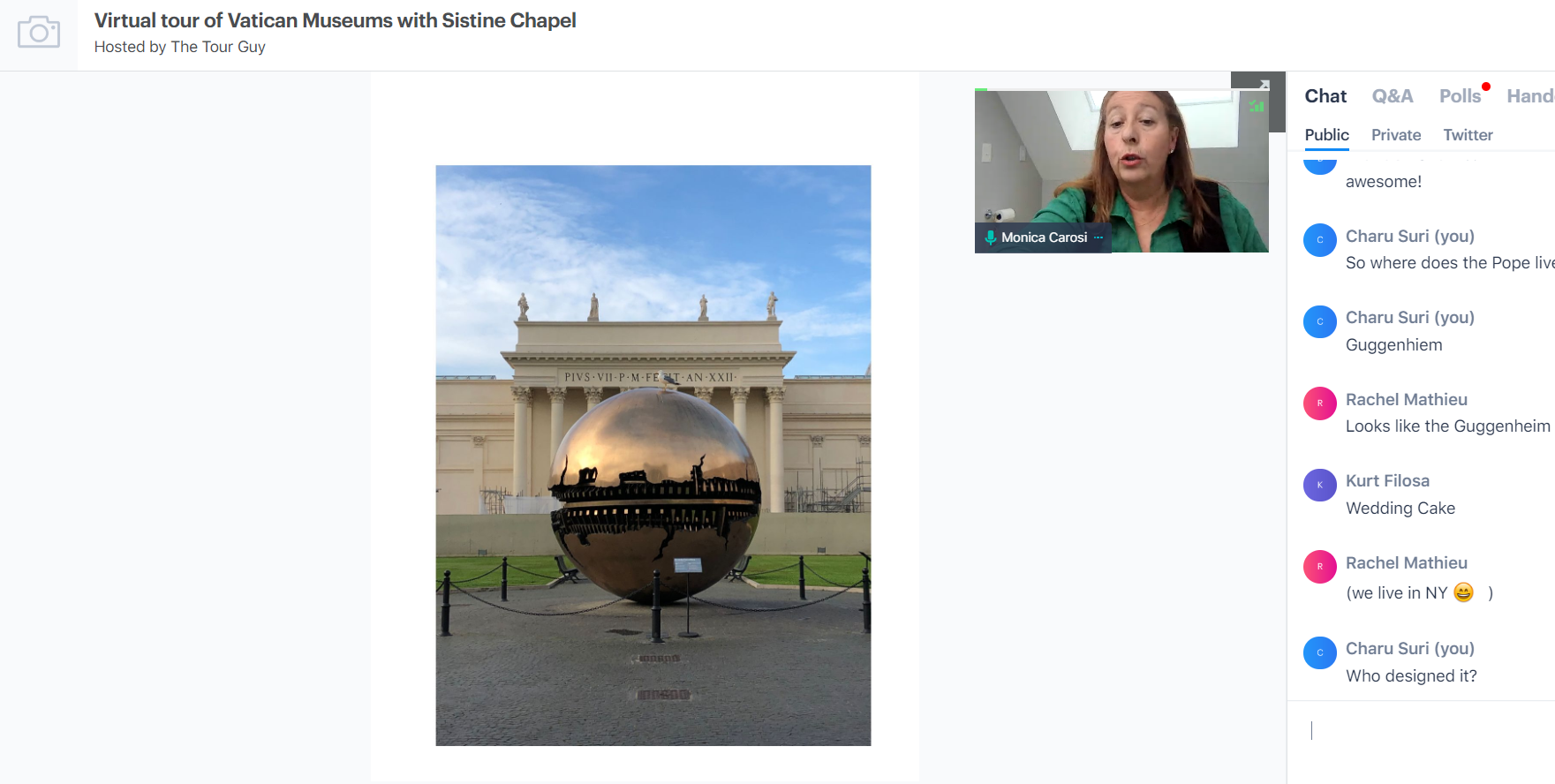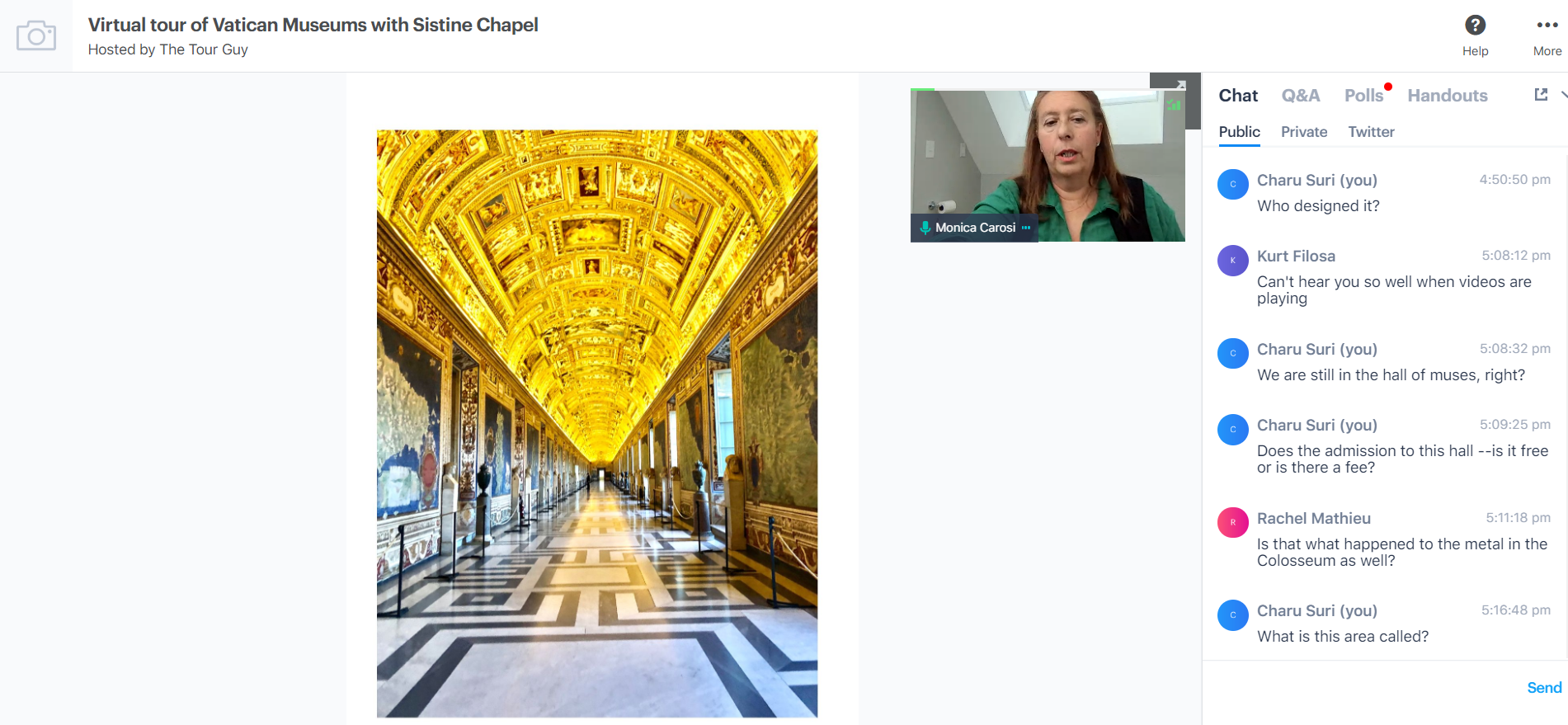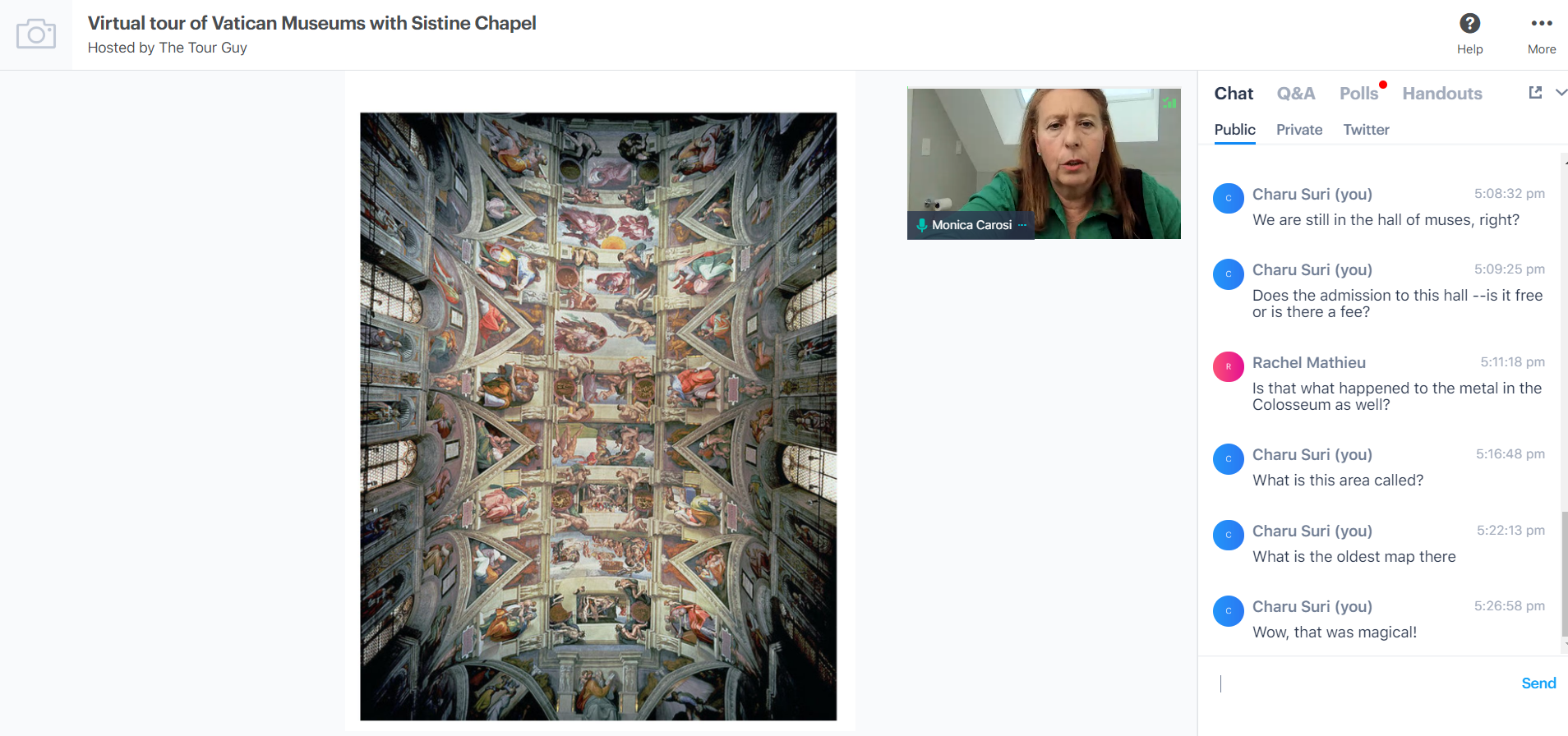Are virtual tours as good as the real thing?
‘Armchair’ tours to places like the Vatican and the Louvre with licensed guides are both educational and inspiring, writes Charu Suri

While most of the tourism industry has ground to a halt in light of the Covid-19 pandemic, some companies have found a silver lining with virtual tours.
Sean Finelli, co-founder and chief executive of The Tour Guy, which has offices in the United Kingdom, launched the company’s first virtual tour about a week ago.
“We didn’t even advertise, and the day after we launched it, we had several bookings,” he said, adding that the inexpensive nature of the tours attracted customers. Most cost €15 (£13.14) for an hour-long tour, and there are 11 options currently, including the exploring the Colosseum, “visiting” the Vatican and Sistine Chapel, learning about the Catacombs in Paris, the Uffizi in Florence and the Louvre in Paris.
“Everyone’s trying to survive right now, and virtual tours have been the answer for us.”
Finelli said that historically, his tours to Italy have been the biggest seller since the company started in 2009. “And that’s not just for me, I think that’s for every tour and travel company on Earth,” he said.
Armchair travellers can visit various places through a webinar-like experience powered by BigMarker, a technology platform much like Zoom. The tours allow you to type your questions in as the licensed tour guide chats.
“The virtual tours have given everyone in my company a sense of purpose; they’re also putting money in the hands of the local guides right now,” said Finelli, who also noted that the cost of attracting a customer for a virtual tour is far less than for an in-person one.
Having felt trapped in my house for days because of social distancing, I was once again eager to “explore” the world.
I signed up for the Vatican and Sistine Chapel and the Louvre virtual tours. I had been to both places several times and was curious to see if a virtual tour would be as informative as an in-person visit. I was also concerned if the experience would be terribly boring, much like a company presentation. Would I tune out in a few minutes?

The tours promised a webinar with photos, videos, fun polls and an interactive chat. Since these were created after the pandemic lockdowns were in place, Finelli explained that it was harder to secure professional video footage; the company encouraged each local guide to construct tours using their personal photos and videos. For me, the personal photos and videos made the experience more authentic and genuine than any airbrushed and edited footage would have done.
For my Vatican tour that was held at 4.30 pm, the sign up was easy. I received a confirmation e-mail and logged on at the appointed time. My Roman tour guide, Monica Carosi, who has been doing what she loves for 20 years, was excited to “see” all of us; four of us had signed up for this tour, and we could hear her clearly.
She started with a bit of Vatican history, including the crucifixion of Peter the Apostle, and Constantine’s advocacy of Christianity in AD313.

My interest was piqued. Just a few minutes into the tour, I already knew the names of the participants and where they were from since each of us had typed this information into the interactive chat window on the right-hand side. I felt as though I had found a travel community after weeks of feeling isolated at home.
Carosi then showed us pictures of the Vatican at the crack of dawn.
“At 6.00 am, one of the 10 clavigeri (keyholders), will show you how the Vatican looks when it opens to the world,” she said. She showed us a video she had taken of one of the galleries – the Gallery of Maps – at that delicate hour when the light barely seeps through the cracks in the window. And then, she fast forwarded to the moment when the lights were turned on. All of us watching this virtual video saw the maps and frescoes light up as though they were part of a movie set.
Carosi walked us – through pictures and videos – to the entrance of the Vatican, past the papal apartments, the museums and the Egyptian obelisk, which was brought to Rome by Caligula in AD37. “St Peter was crucified near the obelisk,” she said.
I had visited the Vatican several times as a student residing in Rome, studying Latin with the then papal secretary, Reginald Foster. But I had somehow managed to forget that salient fact until Carosi gently reminded me. “Nearly 100 years ago, in 1929, Vatican became the smallest independent country in the world.”
And then the participants were surprised with a small “quiz”, essentially a poll that tested our knowledge so far. (We would receive five more such quizzes, which personally kept me on my toes and attentive to all the facts). I thought that it was a nice way for the guides to maintain engagement.

Over the course of an hour, she showed us over 30 photos, from aerial shots of the Sistine Chapel, the grand stairway entrance, the Carrara marble sculpture of Pope John Paul II done by Alessandrini, and the dreamy courtyard with the signature “umbrella pine trees” that showed us the cupola of the Vatican in the distance.
Her detailed narrative led us through to the Gregorian Etruscan Museum, the Room of Muses which houses the famous Belvedere Torso, and through the three galleries that serve as a prelude to the Sistine Chapel – the Gallery of the Candelabra, Gallery of Tapestries, and the Gallery of Maps – each more impressive than the last.
I picked up so much trivia: all Roman sculptures had inlaid marble or glass eyes (they were often stolen and melted to make glass for windows, said our guide); the tapestries were larger than life because “the Pope at the time, Leone X, wanted carpets that looked like paintings”. It was hard not to marvel at the bravura of the ceiling of the Gallery of Maps, illuminated by the clavigero.
And at last… Carosi paused dramatically before she showed us pictures of the Sistine Chapel. “How did they paint this chapel?” she asked us. “Paint, as we know it in tubes, was created some 180 years ago.” The answer? Precious stones and gems were ground to make colours, and that explained the resplendence of the restored Sistine Chapel.

Even though we gazed at “The Last Judgement” and the frescoes on the ceiling from the glare of personal computers at home, it was hard not to be awestruck by their sheer grandeur. I picked up more trivia from my guide: “Michelangelo painted the Virgin Mary in the chapel when he was 33 years old; and “The Last Judgement” at the age of 64.” The chapel transformed greatly under the papacy, and each Pope wanted to decorate it as best as he saw fit.
We concluded the tour at the Vatican, after learning more about The Pieta and the conclave, the sacred process through which a new Pope is officially chosen. The starkest photo I saw during the tour was that of the current Pope Francis walking in a deserted St Peter’s Square.
At the end of the hour-long tour, I bade farewell to my new guide friend and felt sad to leave.
Could I tip her? Sadly no, she said, but I had the option of purchasing the same tour as a tip since all proceeds go to the guides. I felt that the tour was completely worth the price: for €15 each, I was eager to virtually travel to many more places.

The Louvre’s virtual tour was also uplifting and educational. It was led by Francophile Abbie McLean, who took us from IM Pei’s pyramid entrance to popular treasures including the Winged Victory of Samothrace and the Mona Lisa. It was a whirlwind, information-packed hour of exploring a tiny portion of the museum’s 38,000 pieces. It was also fun to “see” the Mona Lisa without the crowds and learn a little bit about the history of why the painting became so famous.
Finelli added that while these tours are not going to replace the company’s core business, they could be an ancillary product category when everything gets back to normal. For the UK, the company’s second largest market, the virtual tours have resulted in a fair number of bookings, especially from Scotland.
Other companies have started to jump on the virtual tour bandwagon to encourage people to explore the world without leaving their homes.
Chicago Detours recently started its free 20-minute talks on various topics for those who want to learn more about the windy city (tips are suggested). The company, ToursByLocals which has guides in the UK, will roll out virtual tour experiences in the coming weeks, to places like Bari, Italy, and a Picasso heritage tour in Barcelona, Spain.
“The coolest parts about these virtual tours are that you feel really connected to people and we really need that right now,” Finelli said.
Join our commenting forum
Join thought-provoking conversations, follow other Independent readers and see their replies
Comments